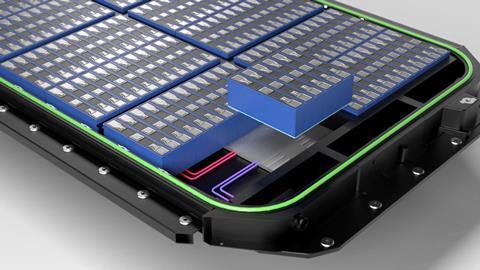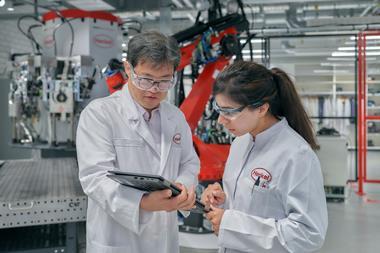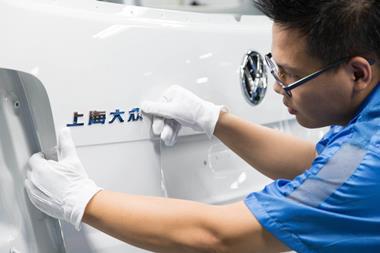PARTNER CONTENT
This content was paid for by Henkel and produced in partnership with Automotive Manufacturing Solutions
More OEMs are looking to build their own EV batteries in-house to streamline production and logistics and have more visibility on costs and efficiencies. In a fast-paced competitive market where technologies evolve and overtake one another quickly, carmakers are keen to keep their progress under wraps – particularly when it comes to battery prototypes. But they are making an exception for the purpose of recycling and repair, according to Henkel’s battery sustainability expert, Philipp tho Pesch.
The ability to build sustainable batteries that allow for repair, reusing and efficient recycling is becoming increasingly important, as OEMs strive to meet sustainability goals and emissions targets, and particularly because the raw materials in batteries such as cobalt, lithium and nickel are so rare and expensive, and often dangerous to source. Repairing and recycling batteries could go some way to alleviating demand.

Batteries that are currently being developed will typically have a structure where the cells are directly integrated into the battery frame. The valuable raw materials – the key part of the battery – are sitting inside the cells. The hydrometallurgical and pyrometallurgical processes used to recycle these metals are mostly established, but these so called cell-to-pack EV battery design poses several challenges. One of the first challenges is the opening and closing of the battery pack itself, as the housing above the module cells are typically sealed and glued. This permanent glue and sealant make it very difficult for repairs. If there is an issue inside the pack, it is imperative to be able to open and close it without causing damage to the structure. Another difficult challenge is separating the cells from the cooling plate, which must be securely attached when in use while also covering thermal properties. If repairability and extending the lifetime or reuse is the goal, then separating the two also needs to be done in a non-destructive way without damaging the cells.
Debonding options and their effectiveness
Philipp tho Pesch, battery sustainability expert at Henkel, says that there needs to be a trigger to debond batteries on demand, as battery cells are becoming a structural component of the battery. The trigger can either be a heat-based thermal trigger or electrical trigger.
With the thermal trigger, temperature is used to debond the adhesive while making sure the battery cell itself never sees a temperature outside its normal operation window. “You always want to make sure that you’re in a safe operation temperature for the battery itself,” says tho Pesch. “It’s a challenge to develop a material that bonds really well until a tipping point in temperature and then loses adhesion immediately. But this is something that we’ve been working on now for quite some time.”
![Philipp tho Pesch[60]](https://d2oevnekjqgao9.cloudfront.net/Pictures/480xAny/4/6/9/318469_philippthopesch60_17860.jpg)
Using an electric trigger, voltage is applied on both side of the adhesive to conductive interfaces, and the ions inside the adhesive will move and create a weak boundary layer which will allow an immediate debond on demand. Because there is no melting involved, it leaves a cleaner slate, allowing parts of the battery pack to be easily replaced and used again.
Handling industry secrets in a competitive market
According to tho Pesch, there has been a lot of interest from the industry in both technologies in development, as they are both “circularity enablers”. Henkel is testing both triggers for different customers as it develops the debonding process. Although they have not gone to market yet, the company is looking to work together with carmakers on potential solutions. Henkel has filed multiple patents in the last year alone, signaling a push by the company to become a pioneer in the area.
Tho Pesch explains that Henkel is working with its customers – primarily carmakers – from the start and going into joint development with them to develop a debonding technology. For IP protection reasons, the OEMs can’t be named just yet, but the company says it is working with a number of leading carmakers. “It’s important to jointly develop a technology so we know how our material works and what kind of requirements a customer has,” he says.
Henkel began developing a lab material prototype to test bonding and debonding, and then moved to a proof-of-concept level. At this level, the process is not customer-specific, and he says Henkel is keen to move to the next step to involve the customers in a closer exchange using the OEM’s prototype.
To do this, Henkel can receive the customer’s battery prototype, or go to the customer’s facility, bringing their materials. Tho Pesch says it’s easier to get the customer’s prototype delivered, as it allows Henkel to carry out multiple fast-iteration trials on it, rather than a one-time test. This is where Henkel’s new Battery Engineering Center comes into play. Located within its €130m Inspiration Center in Duesseldorf, the new 4,300 sq. ft Battery Engineering Center (BEC) features two high-tech facilities – a Battery Application Center (BAC), which opened in August last year, and a Battery Test Center (BTC) due to start operating mid-2024.
The BEC serves as a rapid testing facility for Henkel and its OEM clients, designed to spearhead pivotal technological advancement for the development of next-generation EV batteries. Material application, full-scale battery system testing, simulation and product development are seamlessly integrated under one roof throughout. The BAC and BTC are intended to work seamlessly together, with the help of digital twins and simulations.
And importantly, the BEC allows Henkel to handle OEM battery prototypes safely and securely. Tho Pesch says the centre has standards to ensure that the prototypes are treated with strict confidentiality, affording the carmakers more trust in handing over their commercially-sensitive assets for testing.
It also makes life easier for the OEMs, as they can work with Henkel on everything from product design to technical implementation. Tho Pesch says: “The customer can work with us on the bonding material and then ask, ‘Once I have this material sitting in a bucket in my factory, how do I get the adhesive onto the battery? How do I pump it out? How do I apply it? From a technical point of view, is the density right? Is the application method right?’ All these aspects need to be solved, and by having a battery prototype on site at the BEC, it’s easier to apply this material and have fast iterations of testing.”
Design for repair versus design for recycling
For a business, tho Pesch believes it is more important to design for repair than just purely recycling. “Every design for repair can also be designed for recycling, but not every design for recycling is designed for repair, and that’s the bigger challenge,” he says.

Having a battery pack that is designed for repair and recycling – meaning a battery pack with adhesives that can be easily debonded – is more efficient in the manufacturing process. When a battery is assembled and going into the vehicle production line t goes through an end-of-line check, where small problems can be found with the battery, for example, a module or even a single cell in the battery may not be connected properly. Rather than having to scrap the whole battery pack, which is expensive for the OEM and inefficient, it can be debonded and repaired.
The benefits of having debondable adhesives also come into play in the aftermarket, allowing repairs to more easily take place and costing the consumer less money – a big business case for the OEM.
But interestingly, debondable adhesives on batteries could also save OEMs money in the long run, as it could allow them to retrieve expensive raw materials such as cobalt, graphite and lithium in a more efficient way.
“It’s not only about the price, but also the origin of the materials,” says tho Pesch. “You gain a little bit of strategic independence if you source and re-use your own raw materials, and it comes with little CO2 emissions because it’s recycled in the closed loop. From an environmental point of view, there’s no child labour in the sourcing, guaranteed by using the recycled material. There are a lot of benefits of this.”
He adds that it may take decades to be independent from using virgin material, or at least less reliant on it, but the gains from being more independent in material sourcing can be realised immediately when the cost to source virgin material is currently so high.
Henkel’s progress and upward trajectory
In the past two years, Henkel has set up its BEC and a team completely dedicated to debonding battery adhesives, and it only plans to ramp-up further.
“There is a very strong commitment by Henkel to keep going in this direction because we see so much demand,” tho Pesch says. “We’ve gone from seeing concepts on paper, to physical proof of concepts, to now showing real battery prototypes of customers that we can debond. We are at the final stage of the product development before actually going into a potential product launch.
“Things have been going fast, but it’s intense and collaborative. The topic is so important to the industry and we see that a lot of customers are really interested in this. We are collaborating with the customer to bring this to life, as they can’t do it without us, and we can’t do it without them.”
Learn more about Henkel Adhesive Technologies here.
Click here to learn more about Henkel’s Battery Engineering Center.



































No comments yet